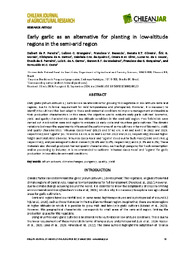Early garlic as an alternative for planting in low-altitude regions in the semi-arid region.
Early garlic as an alternative for planting in low-altitude regions in the semi-arid region.
Author(s): PEREIRA, D. de F.; GRANGEIRO, L. C.; RESENDE, F. V.; OLIVEIRA, R. R. T.; MORAIS, E. G.; SANTOS, E. da N.; QUEIROZ, G. C. M. de; SILVA, I. B. M.; SOUSA, L. M. da S.; FERREIRA, E. de S.; CARMO, L. H. de A.; MEDEIROS, G. B. F. de; GONÇALVES, F. das C.; COSTA, R. M. C.
Summary: Early garlic (Allium sativum L.) cultivars are an alternative for growing this vegetable in low-altitude semi-arid regions, due to its lower requirement for mild temperatures and photoperiod. However, it is necessary to identify the cultivars that best adapt to these environmental conditions to improve management and maximize their production characteristics. In this sense, the objective was to evaluate early garlic cultivars’ biometric, yield, and quality characteristics under low altitude conditions in the semi-arid region. Two field trials were carried out in a Brazilian semi-arid region to evaluate 14 early-cycle and virus-free garlic cultivars. The climatic variations between the experiments influenced the performance of some cultivars in terms of biometric, yield, and quality characteristics. ‘Inhumas Casca Roxa’ (65.25 and 57.62 cm; 6.49 and 6.48 t in 2022 and 2023, respectively) and ‘Ugarte’ (61.70 and 55.14 cm; 6.34 and 5.62 t in 2022 and 2023, respectively) showed higher height and total yield. Likewise, ‘Inhumas Casca Roxa’ and ‘Ugarte’ stood out for bulb mass (20.00 and 19.61 g respectively), and percentage of bulbs in classes 5 (30.6% and 32.8%, respectively) and 6 (8.3% and 9.2%). These materials also showed good post-harvest quality characteristics, such as high pungency for fresh consumption and/or processing by industry. It is recommended to cultivate ‘Inhumas Casca Roxa’ and ‘Ugarte’ for garlic production in low-altitude semi-arid conditions.
Publication year: 2025
Types of publication: Journal article
Unit: Embrapa Vegetables
Keywords: Alho, Allium Sativum, Climate change, Garlic, Mudança Climática
Observation
Some of Embrapa's publications are published as ePub files. To read them, use or download one of the following free software options to your computer or mobile device. Android: Google Play Books; IOS: iBooks; Windows and Linux: Calibre.
Access other publications
Access the Agricultural Research Database (BDPA) to consult Embrapa's full library collection and records.
Visit Embrapa Bookstore to purchase books and other publications sold by Embrapa.

